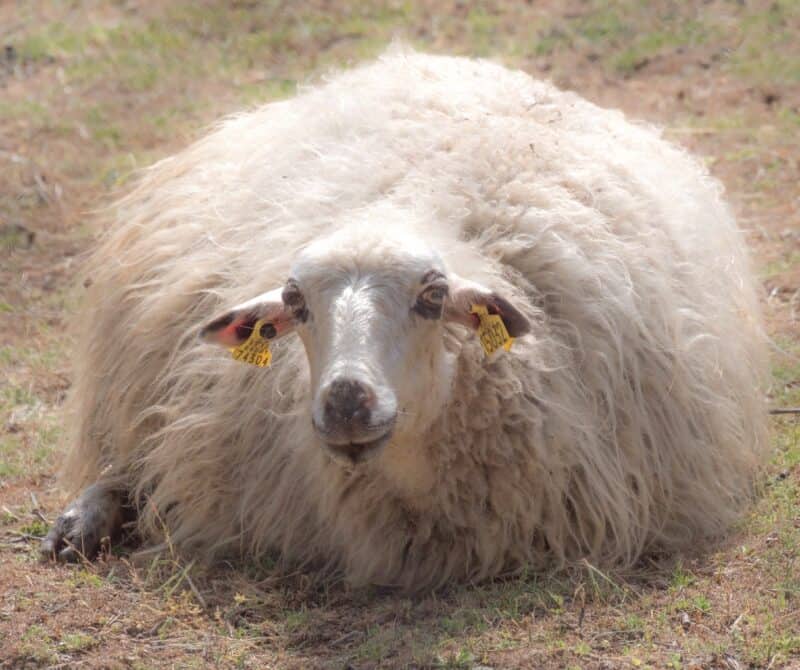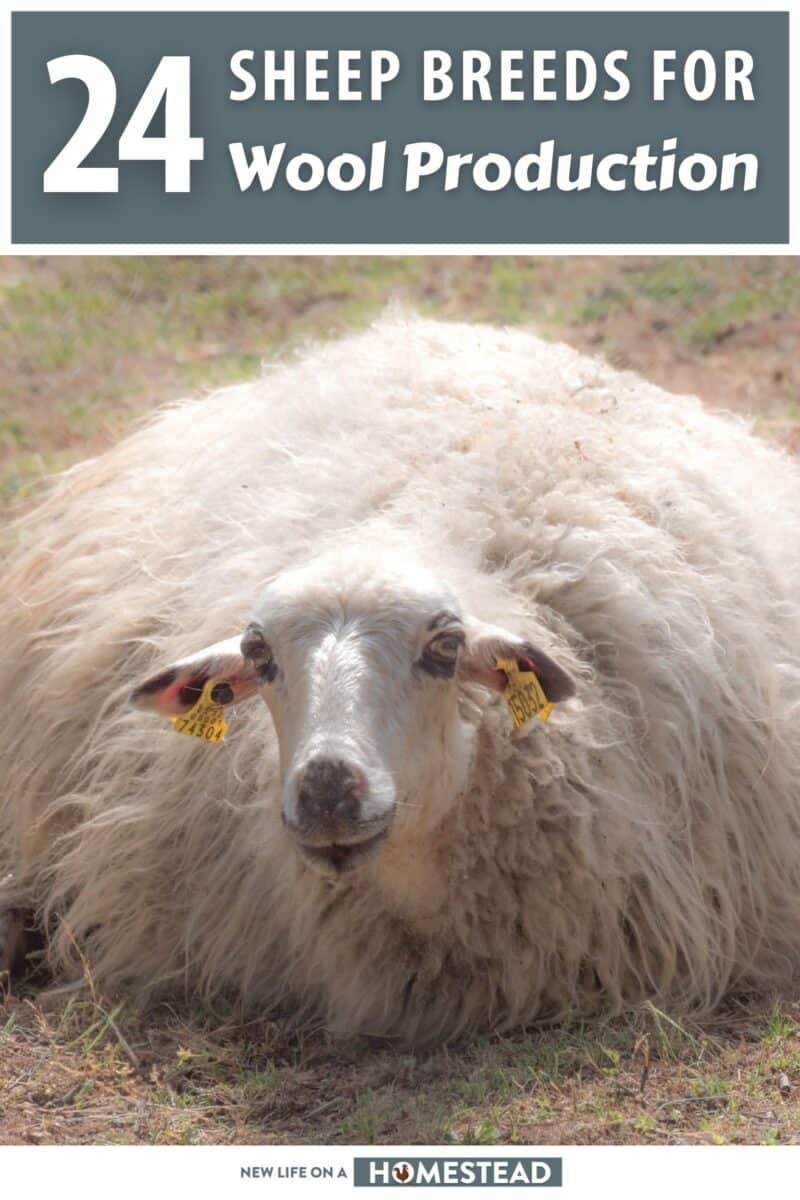Sheep have been farmed for centuries, primarily for their wool. Wool is a natural high-performance fiber used to make clothing, blankets, carpets and a lot more.

And though most sheep have wool suitable for these uses, relatively few sheep have truly excellent wool or other qualities that make them standouts for the purpose.
If you’re looking for a breed of sheep that will produce high-quality wool, or just large quantities of it, then you need look no further than these 24 breeds known for their excellent wool characteristics. Keep reading and we will get right into it…
Table of Contents:
1. Southdown
The Southdown sheep breed is a small British breed, hailing from England, and is known for its fine and short-stapled wool. This breed’s wool is dense and soft, so ideal for creating comfortable clothing.
Southdown sheep thrive in temperate climates where they can graze lush pastures, making them a versatile breed suitable for various environments.
2. Suffolk
Suffolk, originally from England, is a polled breed boasting medium to coarse wool with a long staple length. The wool is perfect for durable textiles such as carpets and upholstery.
These sheep adapt well to different climates but prefer moderate temperatures. Usually raised for meat since they’re large and quick-growing, the Suffolk breed still brings together the best of both worlds in terms of reliable wool quality.
3. Bond
Bond sheep, originating from Australia, are known for their excellent wool qualities, including fine texture and good crimp.
They’re also a particularly high-yield breed. They thrive in a wide range of climates, particularly those with cooler temperatures.
But their origin in the harsh Australian environment has equipped them with the ability to adapt to various conditions, making them a popular choice for folks in arid climates, too.
4. Columbia
The Columbia sheep breed was one of the very first developed in the United States, specifically bred by the USDA for their high-quality wool and adaptability to various temperatures.
Their wool is a long-stapled medium to fine, and suitable for a wide range of applications. Columbias can endure both hot and cold climates, and are a ubiquitous and popular breed today.
5. Rambouillet
Rambouillet sheep, a large, dual-use French breed, are prized for their exceptionally fine and soft wool that shows superb elasticity, making them perfect for luxurious textiles and felt in particular.
These sheep have become a symbol of elegance and sophistication in the wool industry thanks to the quality of their fleeces alone!
6. Coopworth
Coopworth sheep, developed in New Zealand, are known for their versatile and lustrous wool. Their medium to coarse wool is works well in all sorts of applications, from clothing to home furnishings.
A medium-sized breed, the Coopworth is one of the more popular in the lower Pacific Rim, including Australia.
Thrives in temperate climates, reflecting their New Zealand origins, and is well-suited to grazing on diverse pastures.
7. Corriedale
Corriedale is a popular crossbreed that produces soft and radiant high-quality wool, and the sheep are famous for their adaptability to all sorts of conditions and climates.
Their wool is medium to fine with a long staple length, making it ideal for various uses, from clothing to blankets.
Corriedales are a wonderful choice for anyone wanting a versatile, hardy, and productive sheep breed.
8. Clun Forest
The Clun Forest sheep breed is another originating from the borderlands of England and Wales, an area known for both for its rich history and pastoral landscapes.
These multi-use sheep are known for their meat and milk, but also for their dense, medium-quality wool that’s perfect for creating warm and highly durable textiles.
9. Polwarth
Polwarth sheep are properly a sub-type of the Comback sheep elsewhere on this list. The Polwarth produces wool with beautiful crimp and drape.
Most notably, this is one breed that is especially suitable for wet or continually damp environments.
Most sheep don’t do too well in these conditions since both their health and their wool will suffer, but Polwarths don’t seem the least bit troubled by it! If you live in a wet area, Polwarths should be near the top of your list.
10. Targhee
Targhee sheep were developed in the United States as a commercial dual-purpose breed, providing both high-quality wool and meat in abundance.
Their wool is not hugely superior in overall quality, but they are reliable and fat producers.
Their somewhat dull fleece is good for weaving and knitting, or for close-fitting clothes and other similar products. Targhees are a fairly adaptable breed, and do well in different climates.
11. Romney
Originating from the Romney Marsh area in England, Romney sheep are celebrated for their lustrous, long-staple wool that is a fine choice for spinning and weaving.
This is another breed that is well-adapted to wet, marshy environments, and well-suited to regions with high rainfall or damp conditions.
Their robust constitution and excellent behavioral characteristics in very large flocks make them an important breed in the wool trade.
12. Border Leicester
Border Leicester sheep are a polled dual-use breed known for their long, lustrous wool, which is highly sought after by handspinners and weavers, and also for their meat.
This breed originates from the border region between England and Scotland, where it has been prized for centuries.
With their distinctive upright ears and “Roman” nose, Border Leicesters are both important producers, and charming animals in general.
13. Shetland
Shetland sheep hail from the Shetland Islands of Scotland as their name suggests, and are rightly famous for their fine, soft, and colorful wool.
Their fleece comes in a wide range of natural shades, making them a favorite among handspinners and knitters.
These small, hardy sheep are long used to the harsh conditions of their native islands, where they have thrived for centuries.
Long lived, primitive of instinct, and hardy, these are great sheep for rough terrain and hostile climates.
14. Finn
Finn sheep, originating from Finland, and are also known as Finnsheep or Finnish Landrace. This breed produces soft, lustrous wool and is equally well known for their quick adaptability to cold climates.
Their medium-fine fleece is highly sought for its excellent cleanliness, crimp, and elasticity. The Finn’s hardy nature and ability to produce multiple lambs per birth make them a valuable addition to any flock.
15. Lincoln
Also known as the Lincoln Longwool, Lincoln sheep are famous for their ultra-long, heavy wool that is among the heaviest and coarsest in the entire world.
Their impressive fleece is ideal for spinning into strong, durable yarns, making it a popular choice for rugs and other heavy-duty textiles.
Originating from Lincolnshire, England, these large and unique sheep are sadly in danger of extinction since not many viable breeding females are left in the world.
16. Cheviot
Cheviot sheep, thought to have first come from the Cheviot Hills on the border of England and Scotland, are celebrated for their dense, springy wool that is great for spinning and knitting, especially into superb tweed.
These are hardy sheep, a breed that can thrive in a range of climates, from harsh, sparse uplands to green and abundant lowlands.
With their distinctive pricked ears and bald faces, Cheviots are handsome and also highly functional sheep if you want lots of tough wool.
17. Bluefaced Leicester
The Bluefaced Leicester is known for its exceptional wool qualities, with long, lustrous fibers that are notably easy to dye.
The wool is also seemingly perfect for any application requiring a combination of softness but also great strength, so they are always in demand.
And, contrary to what the name suggests, these sheep do not in fact have a blue face. They do, though, have a famously calm and easygoing way about them, making them easy to handle and bond with. Two qualities perfect for wool producers!
18. Wensleydale
Wensleydale sheep boast a lustrous, curly fleece that is soft and highly sought after by handspinners, and it is arguably the very best of all fleeces produced by longwool breeds. And these sheep also boast regal, mysterious gray faces.
With their striking appearance and spiral locks they are among the most interesting sheep on this list.
19. Comeback
Comeback sheep are a versatile breed that can live in all kinds of harsh environments.
Hailing from, of course, Australia, this breed was developed by crossing British longwool sheep with the ubiquitous Merino sheep.
The resulting wool is notably heavy, medium-fine, dense, and springy, making it ideal for felting applications.
20. Hampshire
Also known as the Hampsire Down, the Hampshire breed is known for its stocky, muscular build.
These sheep are primarily raised for meat production, but their wool is also useful for coarse textile products.
With a rich history dating back to the 18th century in England, Hampshires are now popular worldwide for their excellent growth rates and adaptability.
21. Merino
The most ubiquitous and well-known of all sheep kept primarily for wool production. Originating in Spain, Merino sheep are famous the world over for their incredibly fine and soft wool.
They’re also infamous for the prices this wool commands! They thrive in a range of climates, from arid regions to cooler highlands.
The Merino’s wool is rightly prized for its exceptional warmth, breathability, and moisture-wicking properties, making it a go-to choice for luxury garments and active wear alike.
22. Debouillet
Debouillet sheep are a, ah, muddled crossbreed, developed in New Mexico, USA, as a result of crossing Rambouillet and Delaine-Merino breeds.
Although of inspired parentage, they are nonetheless known for their super soft and highly elastic wool, which is perfect for spinning into luxurious yarns.
These sheep prefer a dry climate, naturally, and are right at home in the arid conditions of the American Southwest.
23. Cormo
The Cormo breed was developed in Australia by crossing Corriedale and Merino sheep. Producing a fine, dense, and heavy highly-crimped wool that is famous for its stark “bleached” whiteness.
With its consistent quality wool, the ideal blend stretchiness and softness, and the sheep’s ability to withstand wet conditions that would trouble others, Cormo sheep are a fine choice for anyone living in damp or rainy areas.
24. Dorset Down
Dorset Down sheep (originating from the Dorset Downs region in England, naturally!) are known for their exceptional short wool quality and adaptability to various climates.
The Dorset’s hardy nature and ability to breed year-round makes it a valuable addition to any flock looking to grow quickly and on demand.
But you’ll need to seek these sheep out if you aren’t in the UK: they’re a minority breed at home, and quite rare in North America and Australia.

Tom has lived and worked on farms and homesteads from the Carolinas to Kentucky and beyond. He is passionate about helping people prepare for tough times by embracing lifestyles of self-sufficiency.
